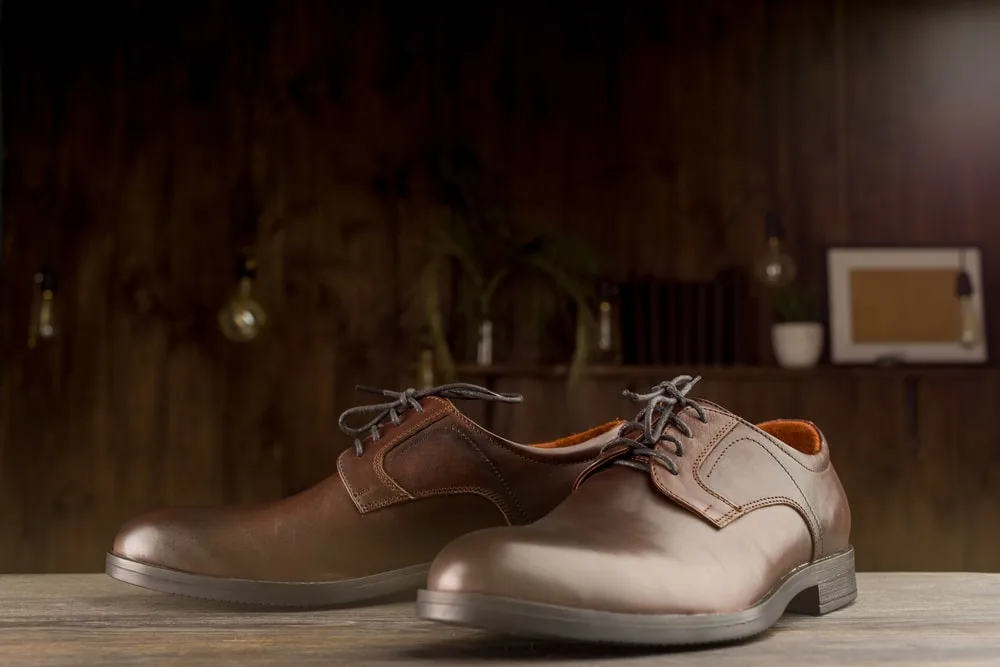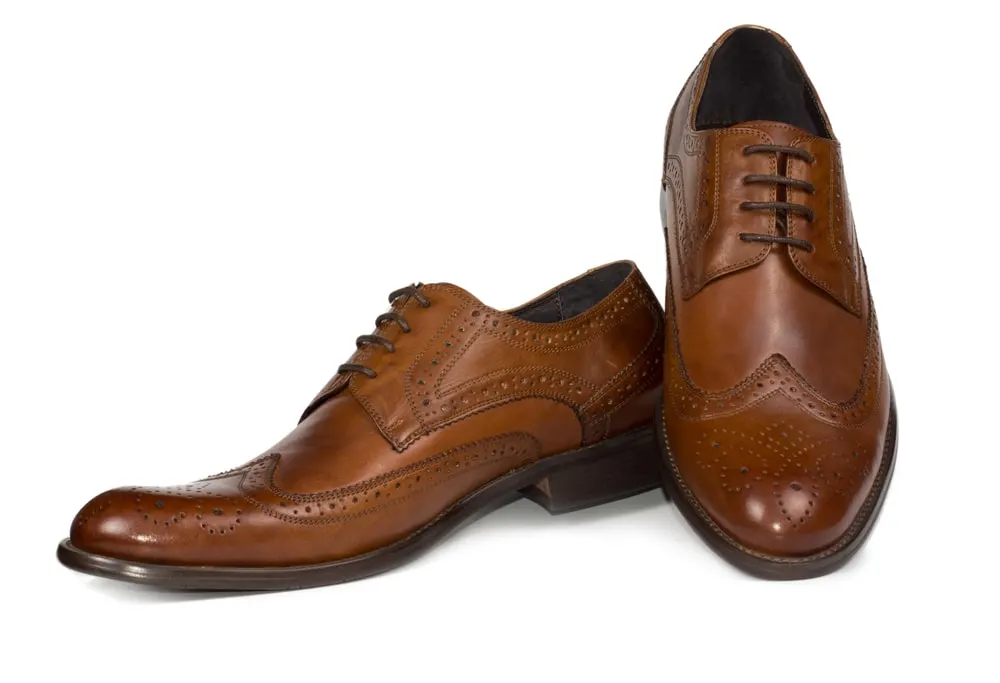Good knowledge of leather shoes is essential, but the names can definitely get confusing. So, what’s the difference between “brogue” shoes and “Derby” shoes?
A “brogue” shoe can be any type of shoe with decorative perforations. In contrast, a “Derby” shoe is a specific style of dress shoe with quarters sewn on top of the vamp creating an open lacing system. Derby shoes can actually be brogue shoes if they have decorative perforations.
Let’s dig a little deeper to clear up any confusion.
Brogue Shoes Vs Derby Shoes
Essentially, the term “brogue” could be applied to any type of shoe with decorative perforations (i.e holes) along the edges of the upper. Usually, however, it’s used to refer to low-heeled, multiple-piece leather dress shoes with perforations.
Here’s a pair of brogue shoes on

“Derby” shoes, on the other hand, are a very specific style of dress shoe known for their quarters with shoelace eyelets sewn on top of the vamp.

It creates the open lacing system they’re so well known for.
Derby shoes can be “brogue” shoes – that’s the key point to take away.
If those Derby shoes have decorative perforations lining the edges of the upper – they’re “brogue Derby shoes”.
You can get brogue Derbys, brogue Oxfords, and even brogue monkstraps. It really just depends on whether those fancy perforations are present or not.
It’s a common mistake people make – confusing “brogue” for a specific type of shoe as opposed to just a feature that many types of shoe can have.
But the term “brogue shoe” doesn’t tell you anything about the style of the shoe itself. All it tells you is that the shoe has decorative perforations.
Let’s talk about brogue shoes in a little more detail.
Brogue Shoes
They’ve got a pretty bold and eye-catching appearance, but brogue styles can vary quite a lot. Sure, they all have those glorious perforations. But the perforation style itself can differ.
Brogue Styles
These are the main styles of “brogue-ing” you’re likely to see with dress shoes.
Full Brogue (Wingtip)
These are shoes with a pointed toe cap that’s shaped like a “W”. The decorative perforations line the edges but are also included in the middle of the toe cap.

Image From Deposit Photos
The fancy perforations in the center of the toe cap form the “medallion”.
Full brogues are also known as “wingtips”, referring to the wing-like appearance of the toe cap. It’s fine to use either term.
Semi Brogue
Semi brogues (a.k.a half brogues) do not have the “W” shaped toe cap that full brogues do. Instead, they have a straight toe cap that simply extends horizontally from one side of the vamp to the other.
Here’s a pair of semi-brogue Oxford shoes as an example on

The edge of the toe cap is adorned with brogue perforations. In addition, semi brogues usually do feature a medallion.
Semi brogue shoes have a more subtle and formal appearance to them than the bolder and more casual wingtip.
Quarter Brogue
Quarter brogues are by far the most subtle style of brogue shoes. Much like semi-brogues, they have a straight toe cap with no “W” shape and also have perforations lining the horizontal edge of this toe cap.
However, unlike semi brogues, quarter brogues do not have a medallion in the center of the toe cap.
Here’s a pair of quarter brogue monkstrap shoes on

As a result, the perforations aren’t as obvious – this leads to a more formal and “professional” appearance.
Longwing Brogue
Longwing brogues are very similar to full brogues, but the difference comes down to the wings of the wingtip.
With longwings, the wings extend down the entire length of the sides of the shoe and meet at the heel.
Brogue Shoes: How To Choose
When choosing a type of brogue shoe, you’ll need to consider the style of shoe and the style of brogue-ing.
Formality is the main factor that should influence your decision. Brogue shoes vary hugely in terms of their formality.
Overall, decorative perforations will always be a casual feature. But even brogue shoes can be appropriate for more formal dress codes, depending on the type.
I’ve listed the main dress codes below, along with examples of the type of brogue shoe that may be appropriate for each of them.
Formal Or Business Professional
This is where you’ll need to be wearing a formal suit, whether that’s to a specific event or to a corporate work setting.
Quarter brogues are by far the best option, as you’ll want to keep the decorative perforations as subtle as possible. A medallion on the toe cap doesn’t look great when wearing a formal suit.
Stick to brogue Oxfords if possible, as the closed lacing system will always look more formal than the open lacing system of Derby shoes.
However, a dark pair of brogue Derbys would probably be fine too.
Business Casual
You’ve got more freedom here. These are settings where chinos, cardigans, Oxford shirts, blazers, and sports coats reign supreme.
Suits and ties are too formal.
With business casual dress codes, semi brogue Derbys or monkstraps are great options as they strike such a great balance between formal and casual.
Full brogues can work too – just ensure that the setting you’re going to is more on the “casual” end of the business-casual spectrum.
Smart Casual
Taking it one notch less formal, the “smart casual” dress code is where a pair of dark jeans, chinos, polo shirt, or Henley shirt would be perfectly appropriate. Think first dates, dinners at mid-level restaurants, etc.
Here, a pair of full brogues could look great, especially when worn with chinos. It’s a great way to really stand out with your smart-casual outfit.
Derby Shoes
Derby shoes are a hugely popular form of dress shoe, but it’s important to know how to identify them and what settings they’re most appropriate for.
Key Features
Derby shoes have large, prominent quarters sewn onto the sides. They wrap all the way around the heel and sides before meeting at the vamp.
Importantly, these quarters are sewn on top of the vamp instead of under it. This leads to the open lacing system that Derbys are known for.

Image From Deposit Photos
It’s a fancy way of saying that the lacing system forms flaps that can be separated easily, unlike the closed lacing system of Oxford shoes.
The open lacing system makes Derbys comfortable to wear and ideal for men with wide-set feet.
In addition, it gives Derbys a slightly less formal appearance than Oxfords. In many ways, this makes Derby shoes incredibly versatile.
Ideal Settings
Let’s explore the versatility of Derby shoes in a little more detail. What sort of settings are they best suited for?
In general, Derby shoes can be worn in many settings ranging from formal to smart-casual.
The open lacing system gives it a laid-back feel and it won’t look that out of place in a smart-casual setting.
However, the best dress codes for Derby shoes are formal and business casual.
There are certain features that define how formal a specific pair of Derby shoes will look. Here are a few that will generally make them look more formal:
- Leather instead of suede.
- Dark colors eg. black or dark brown.
- No brogue patterns.
- A single uniform color (i.e no spectator shoes).
So, if you’re looking to wear a formal suit to a formal or business-professional setting, look for those features to ensure your specific pair of Derby shoes looks formal enough.
If, on the other hand, you’re attending a business-casual or smart-casual setting, you’ve got a bit more freedom.
Bolder and brighter colors, suede uppers, decorative patterns, and spectator shoes are all possibilities.
What about tuxedos?
Derby shoes can be worn with tuxedos, but it’s important you get them in the right material. Patent leather Derbys can work well, while standard calfskin leather would not look formal enough.
Derby Shoes: Brogue Vs Not Brogue
So, now that we’ve established that Derby shoes can be brogue shoes as long as they include decorative perforations, how do you choose between brogue Derbys and normal Derbys?
Overall, it really depends on how formal the setting you’re attending is.
The more formal the setting, the less brogue patterning you can get away with. As we discussed earlier, brogue Derbys can be full brogue (i.e wingtips), semi-brogue, and quarter-brogue.
If the setting you’re attending is very formal or black tie, avoid brogue Derbys altogether.
But even if you feel that the “formal” dress code really isn’t that formal, when wearing a formal suit, don’t go any further than quarter-brogues as they’ll likely start to look too informal.
Stick to dark leather as well.
For business-casual settings where chinos and a cardigan would be perfectly acceptable, you could definitely get away with semi-brogues but once again, don’t go for too bright or bold of a color.
If the setting is more on the “casual” end of the business-casual spectrum, wingtips (full brogues) may be OK if you stick to dark leather, but it’s definitely more of a risk.
For cocktail attire and smart-casual settings, you’ve got a lot more freedom when it comes to brogue Derbys. Wingtips, spectator shoes, and suede are usually possible.
So, the decision should really be based on the formality of the dress code. Ultimately, brogue patterns really are a casual feature of any style of shoe, including Derby shoes.
Conclusion
There you have it. Hopefully everything you needed to know about brogue patterns and Derby shoes.
If you were to only take away one thing, let it be this:
Derby shoes are a style of shoe with a very specific construction.
“Brogue” is a feature that can be included in many different types of shoes, including Derby shoes.
Enjoy.
Ready Sleek founder. Obsessed with casual style and the minimalist approach to building a highly functional wardrobe. Also a fan of classic, vintage hairstyles.

![Brogue Vs Derby: What’s The Difference? [Solved]](https://www.readysleek.com/wp-content/uploads/2021/10/Brogue-vs-derby-720x405.jpeg)





